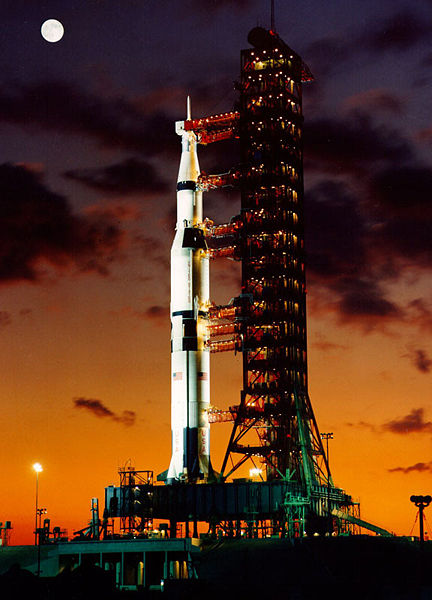Biggest Space Rocket Ever Made Put on Display!
 Saturn V, commonly known as the Moon Rocket, was the first rocket to carry a manned mission into space for a lunar landing. On 16th July 1969, it launched the Apollo 11 mission into the Earth's orbit and put the first man on the Moon.
Saturn V, commonly known as the Moon Rocket, was the first rocket to carry a manned mission into space for a lunar landing. On 16th July 1969, it launched the Apollo 11 mission into the Earth's orbit and put the first man on the Moon.
Now, after more than 35 years of laying outside the neighboring U.S. Space & Rocket Center, NASA is putting the colossus on display for the large public.
It stands 110 meters tall, 10 meters in diameter, weighs 3 million kilograms and, when functional, its 5 Rocketdyne F-1 engines were able to output about 34 MN of thrust, but it was not the most powerful rocket ever made. Only the Russian rocket Energia was able to provide with more thrust, regardless of the fact that it only flew in two test missions. Saturn V was designed under the direction of German rocket builder Wernher von Braun, at the Marshall Space Flight Center.
The 23.4 million U.S. dollar project was started two and a half years ago so that the renovated rocket would be ready in time for the 50th anniversary of the launch of the first U.S. artificial satellite. To house the rocket, a 6335 square meter building had to be raised by the museum hired contractor, using money received from donations, federal grants, local funding and bond money. The shear size of the rocket disabled the possibility to move it into its new home in one piece, and now lies split up in sections for display.
Although it stood in the Alabama sun and was house for families of raccoons, birds, green algae and possums for the last three decades, Larry Capps, the CEO of the Museum, says the rocket didn't requires as much work as originally estimated. New paint and replacement of fragile metal made the Saturn V rocket look like in its days of glory. On the other hand, the capsule wasn't so fortunate, and due to the bad shape, it had to be scrapped and a substitute mockup had to be found. Capsule and escape tower have been provided by the Marshall Space Flight Center from its personal 'bone yard'.
"The construction of its new home, moving and restoration of the rocket cost the museum about 9.5 million dollars, the rest of the money being spent on the new visitor center", said Larry Capps. As putting the rocket in a upright position would have restricted much of the visitors from viewing the whole structure, thus the museum decide to lay it on its side, with the first of the two stages and the upper sections suspended on thin cables.
Also, the museum has in plan to move even more of Apollo mission artifacts to the newly erected building. Just outside, a replica of a Saturn V stands in a upright position. Similar rockets are being displayed at the Kennedy Space Centers in Florida and Huston, and at the Johnson Space Center, which completed its restoration only one year ago, at a cost of 5 million dollars.







0 comments:
Post a Comment